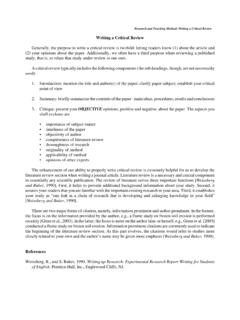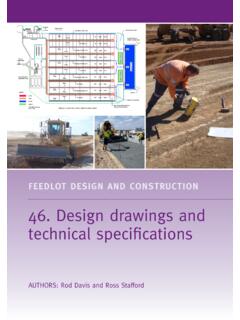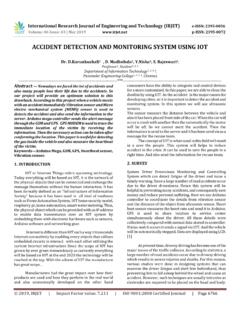Transcription of Lecture 2 Introduction to GIS (Based on lecture notes of ...
1 Lecture 2. Introduction to GIS. (Based on Lecture notes of Dr. Piotr Jankowski, former professor in Department of Geography at UI). Objective The purpose of this Lecture is to provide an Introduction to GIS and give an overview of basic theoretical and technical concepts in GIS. Contents 1. What is GIS. 2. Spatial Data Models Data Model Data Model 3. Map Projections and Coordinate Systems in GIS. 1. What is a GIS? A Geographic Information system (GIS) is a computer system for capturing, storing, querying, analyzing, and displaying geographic data. Like any other information technology, GIS can be divided into the following four components: computer system , GIS software, brainware, and infrastructure. Computer system The computer system includes the computer and the operating system to run GIS. Typically the choices are PCs that use the Windows operating system ( , Windows 2000, Windows XP). or workstations that use the UNIX operating system .
2 Additional equipment may include monitors for display, digitizers and scanners for spatial data input, and printers and plotters for hard copy data display. GIS Software The GIS software includes the program and the user interface for driving the hardware. Common user interfaces in GIS are menus, graphical icons, and commands. Brainware Equally important as the computer hardware and software, the brainware refers to the purpose and objectives, and provides the reason and justification, for using GIS. Infrastructure The infrastructure refers to the necessary physical, organizational, administrative, and cultural environments for GIS operations. The infrastructure includes requisite skills, data standards, data clearinghouses, and general organizational patterns. Since the 1970's, GIS has been important in natural resource management, such as land use planning, timber management, wildlife habitat analysis, riparian zone monitoring, and natural hazard assessment.
3 In more recent years, GIS has been used in emergency planning, market analysis, facilities management, transportation planning, and military applications. Integration of GIS with other technologies such as global positioning system (GPS) and the Internet has introduced new applications. To learn more about GIS, go to the Geological Survey web site ( ). The ability of GIS to handle and process geographically referenced data distinguishes GIS from other information systems. Geographically referenced data describe both the location and characteristics of spatial features on the Earth's surface. Roads and land use types are spatial features as are precipitation and elevation. In describing a road, for example, we need to refer to its location ( , where it is) and its 1. Lecture 2. characteristics (road classification, traffic volume, etc). GIS therefore involves two geographic data components: spatial data relating to the geometry of spatial features, and attribute data giving the information about the spatial features.
4 2. Spatial Data Models GIS uses two basic data models to represent spatial features: vector and raster. The data model determines how the data are structured, stored, processed, and analyzed in a GIS. The vector data model uses points and their x, y coordinates to construct spatial features of points, lines, and areas. Vector-based features are treated as discrete objects over the space. The raster data model uses a grid to represent the spatial variation of a feature. Each cell in the grid has a value that corresponds to the characteristic of the spatial feature at that location. Raster data are well suited to the representation of continuous spatial features like precipitation and elevation. Many GIS functions are either vector-based or raster-based. Vector Data Model The vector data model consists of three types of geometric objects: point, line, and area. A point may represent a gravel pit, a line may represent a stream, and an area may represent a vegetated area.
5 A point has 0 dimension. A point feature occupies a location and is separate from other features. A line is one-dimensional and has the property of length. A line feature is made of points: a beginning point, an end point, and a series of points marking the shape of the line, which may be a smooth curve or a connection of straight-line segments. Line features may intersect or join with other lines and may form a network. An area is two-dimensional and has the properties of area and boundary. The boundary of an areal feature separates the interior area from the exterior area. Areal features may be isolated or connected. They may overlap one another, and may form holes within other areas. Vector data representation using point, line, area, and volume is not always straightforward because it may depend on map scale and, occasionally, criteria established by government mapping agencies. A city on a 1:1,000,000-scale map is represented as a point, but the same city is shown as an area on a 1:24,000-scale map.
6 A stream is shown as a single line near its headwaters but as an area along its lower reaches. In this case, the width of the stream may determine how it should be represented on a map. The Geological Survey (USGS) uses single lines to represent streams less than 40 feet wide on 1:24,000-scale topographic maps and double lines for larger streams. When hydrography becomes a layer in Digital Line Graph (DLG) data, streams in single lines are digitized as lines, and streams in double lines are digitized as areas. Therefore, a stream may appear as a line or an area depending on its width and the criterion used by the government agency involved in creating the maps. Vector data may be topological or non-topological. ARC/INFO coverages are topological and shapefiles are non-topological. Topology expresses explicitly the spatial relationships between geometric objects. ARC/INFO coverages support three basic topological concepts: Connectivity: Arcs connect to each other at nodes Area definition: An area is defined by a series of connected arcs Contiguity: Arcs have directions and left and right polygons 2.
7 Lecture 2. ArcView uses non-topological shapefiles. Shapefiles define the geometry and attributes of map features in three basic files. The .shp file stores the feature geometry, the .shx file maintains the index of the feature geometry, and the .dbf file stores the attributes of map features. Although the feature geometry file in ArcView saves a point as a pair of X, Y coordinates, a line as a series of points, and a polygon as a series of lines, no files describe the spatial relationship among geometric objects. For example, polygons in a shapefile have duplicate arcs and can overlap one another, thus violating the topology required for a polygon coverage. Without topology, shapefiles can create problems in some GIS analysis, such as topology-based map overlay and network analysis. Use of shapefiles, however, has two main advantages: (1) they display more rapidly on a view than ARC/INFO coverages, and (2) they are not proprietary and can be used directly in other GIS software packages such as MapInfo and GeoMedia.
8 Shapefiles can be converted to ARC/INFO coverages, and vice versa. The conversion from a shapefile to a coverage requires the building of topological relationships and the removal of duplicate arcs. The conversion from a coverage to a shapefile is simpler. But if a coverage has topological errors, such as lines not joined perfectly, the errors can result in missing features in the shapefile. Raster Data Model The raster data model uses a regular grid to cover the space and the value in each grid cell to correspond to the characteristic of a spatial phenomenon at the cell location. Conceptually, the variation of the spatial phenomenon is reflected by the changes in the cell value. Raster data have been described as field-based, as opposed to object-based vector data. A wide variety of data used in GIS are encoded in raster format. They include digital elevation data, satellite images, digital orthophotos, scanned maps, and graphic files.
9 Most GIS packages can display raster and vector data simultaneously, and can convert from raster to vector data or from vector to raster data. Raster data also introduce a large set of data analysis functions to GIS. Integration of both vector and raster data is a common feature in a GIS project . A grid consists of rows, columns, and cells. The origin of rows and columns is at the upper left corner of the grid. Rows function as Y coordinates and columns as X coordinates in a two-dimensional coordinate system . A cell is defined by its location in terms of row and column. The cell size determines the resolution of the raster data model. A cell size of 30 meters means that each cell measures 30 30 meters. Raster data represent points by single cells, lines by sequences of neighboring cells, and areas by collections of contiguous cells. Each cell in a grid carries a value, either an integer or a floating-point value (a value with decimal digits).
10 Integer cell values typically represent categorical data ( , nominal or ordinal data). For example, a land cover model may use 1 for urban land use, 2 for forested land, 3 for water bodies, and so on. Floating-point cell values represent continuous data ( , interval or ratio data). For example, a precipitation model may have precipitation values of inch, inch, and so forth. 3. Map Projections and Coordinate Systems in GIS. Map projection transforms the spatial relationship of map features on the Earth's surface to a flat map. Map projection enables a map user to work with two-dimensional coordinates, rather than spherical or three-dimensional coordinates. But the transformation from the Earth's surface to a flat surface always involves distortion and no map projection is perfect. This is why hundreds of map projections have been developed for mapmaking, each with its own parameters. 3. Lecture 2. A coordinate system is based on a map projection.









